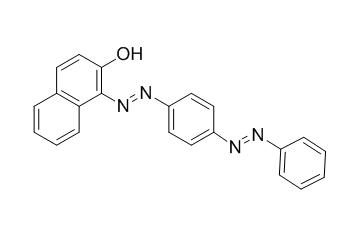Sudan III
C.I. Solvent Red 23, commercial Sudan III, is widely used in cosmetic products, it has mutagenic activities. Sudan III dye strongly induces CYP1A1 mRNA expression in HepG2 cells.
Inquire / Order:
manager@chemfaces.com
Technical Inquiries:
service@chemfaces.com
Tel:
+86-27-84237783
Fax:
+86-27-84254680
Address:
1 Building, No. 83, CheCheng Rd., Wuhan Economic and Technological Development Zone, Wuhan, Hubei 430056, PRC
Providing storage is as stated on the product vial and the vial is kept tightly sealed, the product can be stored for up to
24 months(2-8C).
Wherever possible, you should prepare and use solutions on the same day. However, if you need to make up stock solutions in advance, we recommend that you store the solution as aliquots in tightly sealed vials at -20C. Generally, these will be useable for up to two weeks. Before use, and prior to opening the vial we recommend that you allow your product to equilibrate to room temperature for at least 1 hour.
Need more advice on solubility, usage and handling? Please email to: service@chemfaces.com
The packaging of the product may have turned upside down during transportation, resulting in the natural compounds adhering to the neck or cap of the vial. take the vial out of its packaging and gently shake to let the compounds fall to the bottom of the vial. for liquid products, centrifuge at 200-500 RPM to gather the liquid at the bottom of the vial. try to avoid loss or contamination during handling.
Antioxidants (Basel).2024, 13(8):951.
Braz J Med Biol Res.2021, 54(12):e11183.
J Korean Soc Food Sci Nutr2020, doi: 10.3746.
Lab Chip.2018, 18(6):971-978
Molecules.2021, 26(9):2802.
American Association for Anatomy2020, doi: 10.1002.
Food Res Int.2021, 148:110607.
Phytomedicine.2019, 67:153159
Front Pharmacol.2019, 10:1025
Plants (Basel).2020, 9(11):1422.
Related and Featured Products
J. Biochem. Mol. Toxicol.,2012 Jan;26(1):16-22.
Sudan III dye strongly induces CYP1A1 mRNA expression in HepG2 cells.[Pubmed:
22287322 ]
Sudan dyes possess a high affinity to the aryl hydrocarbon receptor (AHR) and potently induce its target genes, such as cytochrome P450 (CYP) 1A1, through unknown mechanisms.
METHODS AND RESULTS:
We investigated a detailed event occurring in cells after binding of Sudan dye to AHR in HepG2 cells. Treatment with 10 µM Sudan III caused rapid translocation of AHR into the nucleus and increased expression levels of human CYP1A1 mRNA by approximately 20-fold after 16 and 24 h. The transactivation was due to the activation of a region located at -1137 to +59 bp from CYP1A1, in particular, four xenobiotic responsive elements (XREs) existing in the region.
CONCLUSIONS:
AHR and the Ah receptor nuclear translocator interacted with XRE sequences in a gel shift assay using nuclear extract from Sudan III--treated HepG2 cells. Moreover, we suggest that constitutive androstane receptor could modify CYP1A1 transactivation by Sudan III.
Japanese Journal of Toxicology & Environmental Health, 1985, 31(2):79-86.
Mutagenic activities of commercial Sudan III and Scarlet red are due to impurities.[Reference:
WebLink]
METHODS AND RESULTS:
Commercial samples and pure chemical samples of Sudan III (C. I. 26100) and Scarlet Red (C. I. 26105) were tested for mutagenic activities in the Ames test. Three out of five commercial samples of Sudan III were mutagenic to Salmonella typhimurium TA98 and TA100 in the presence of S9 mix, and all of the commercial samples of Scarlet Red tested were mutagenic to the two strains with microsomal activation. Neither of the purified dyes, however, was mutagenic to these strains with or without S9 mix.
CONCLUSIONS:
These results demonstrate that contaminants present in these commercial diazodyes were responsible for the mutagenic activity. Some of the contaminants were separated by preparative thin layer chromatography, and the starting materials of the azo-dyes, i. e. p-aminoazobenzene (AB) and o-aminoazotoluene (oAT), were found to be the main mutagenic contaminants.
Contact Dermatitis. 1991 Nov;25(5):313-8.
Identification of contact allergens in C.I. Solvent Red 23 (commercial Sudan III) by chemical analysis and animal testing.[Pubmed:
1725669]
C.I. Solvent Red 23, commercial Sudan III, is widely used in cosmetic products. Chemical analyses and guinea pig sensitization tests were carried out to identify its contact allergens.
METHODS AND RESULTS:
In the Magnusson & Kligman guinea pig maximization test, C.I. Solvent Red 23 showed 20% positive reactions. By conducting chemical analyses with HPLC and GLC, 2-naphthol (82 ppm), azobenzene (48 ppm), Sudan I (570 ppm) and many unknown impurities, as well as the main constituent pigment Sudan III (87%), were found. The chemical structure of one unknown impurity was identified as an isomer of Sudan III. We found that purified Sudan III showed no positive reaction, while the isomer elicited 30% positive reactions, in the same guinea pig test. Furthermore, cross-sensitization with p-phenylenediamine was investigated using the guinea pig test. Animals sensitized with p-phenylenediamine also showed positive elicitation reactions with purified Sudan III.
CONCLUSIONS:
From these results, the contact allergenicity of C.I. Solvent Red 23 is considered to be due to impurities, including the isomer of Sudan III, 1-(o-phenylazophenylazo)-2-naphthol. Positive reactions to Sudan III previously demonstrated in hairdressers are due to cross-sensitivity with p-phenylenediamine.



